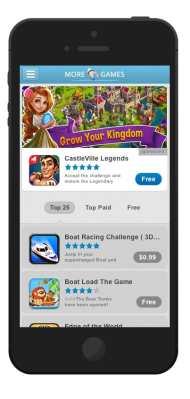Just over a year after InMobi bought MMTG Labs, the mobile ad company is today unveiling the first big product to come out of the acquisition: a new version of its AppGalleries offering, which lets publishers create their own app storefronts with ads incorporated into them. Today the service is debuting with a redesigned UI with more flexibility for publishers to curate their apps, along with some clever algorithms of self-populate the stores, too.
This is part of a wider refresh at InMobi that is also seeing the company unveil new custom ad formats designed around templates for games, weather apps, utility apps and so on, to encourage more clicks from those seeing the ads.
Ryan Merket, the co-founder of MMTG who is now director of product at InMobi, says that MMTG was onto a good thing with the idea of white-label app stores for publishers, which were originally called AppStores, a domain that InMobi now owns and redirects to AppGalleries. It’s hard to find apps that are relevant to you, so for consumers who already feel loyal to a certain app or brand, those consumers may look to them for more curated selections. The problem was that MMTG lacked a strong enough monetization model behind it.
“We decided to get acquired because we would have had to build an ad network from scratch to support what we wanted to do, and it was hard to articulate this vision to VCs to garner the resources we needed,” Merket tells me. “InMobi had the tech to help us fulfil that vision.”
InMobi today is one of the bigger independent ad networks around. There are some 691 million users on its network — second only to Facebook, Merket tells me — and more than Millennial Media combined now with Jumptap. There are some 30,000+ apps and sites on the InMobi network, which works out to InMobi touching more than 60% of all mobile Internet users, and 40% of the global smartphone population. InMobi’s existing mobile app install ads have led to some 50 million downloads to date.
The idea with the AppGalleries, which are free for publishers to create, is that they will be able to select any apps that they would like to run in their personalized app stores. Those apps can also be auto-populated based either on InMobi’s own selection of apps, or content on your own site. As one example, Merket suggested that a blog that writes app reviews could create an AppGalleries storefront that aggregates all the apps that have ever been reviewed by the blog, by way of some java code. This is retroactive, he says: putting code on, say, TechCrunch could see a new storefront created in “about 10 minutes” with all the apps we’ve ever written about in it. What’s more, InMobi can also modify, automatically, the links in the actual posts so that subsequent links to apps go directly to the publisher’s app store, rather than that of iTunes or Google Play.
As for monetizing, any of those app links can be turned into paid ads, a publisher can sell in their own ads, or they can use those from InMobi’s network. The bare minimum, Merket says, is that at least one InMobi based ad — demarcated with a “sponsored” tag — needs to appear in the list. InMobi says that early tests of the galleries has seen an increase of up to 600% in app download conversion rates; and eCPMs of up to $12 (compared to a typical $1-3 on mobile ads).
Given the success that Facebook and others have had with app install ads, the idea of expanding that concept into a full app storefront with a mix of those ads with actual curated app listings makes some sense. So does the fact that InMobi is trying to make AppGalleries as ubiquitous as possible. Built on HTML5, they can be used both on mobile web sites as well as within native iOS or Android apps (no word on Windows Phone or other platforms for now). And they can be accessed either via interstitials, as standalone apps, or via links from the publishers’ apps themselves
“Facebook” is the operative word here, too: Merket says that InMobi is currently in advanced testing with one of the “top three” social networks to roll this out on their own platform. He says he’s bound to secrecy over which one it is, but you can see how this model could be implemented by the likes of Facebook, Twitter or LinkedIn. All of them are hyper aware that the biggest user growth is coming not from desktop but mobile, and so the big question is how to keep people engaged on a platform that lends itself to very short bursts of usage. Extended time on the platform would be in all three companies’ interest because that increases the likelihood of serving ads and getting a response.
